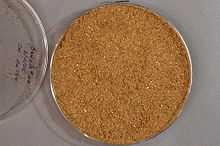Meat and bone meal

Meat and bone meal (MBM) is a product of the rendering industry. It is typically about 48–52% protein, 33–35% ash, 8–12% fat, and 4–7% moisture. It is primarily used in the formulation of animal feed to improve the amino acid profile of the feed. Feeding of MBM to cattle is thought to have been responsible for the spread of BSE (mad cow disease). In most parts of the world, MBM is no longer allowed in feed for ruminant animals. However, MBM is still used to feed monogastric animals. It is widely used in the United States as a low-cost meat in dog food and cat food.[1]
In Europe, some MBM is used as ingredients in petfood but the vast majority is now used as a fossil-fuel replacement for renewable energy generation, as a fuel in cement kilns, landfilling or incineration.
Meat and bone meal has around two thirds the energy value of fossil fuels such as coal; the UK in particular widely uses meat and bone meal for the generation of renewable electricity. This was particularly prominent after many cattle were slaughtered during the BSE crisis.
Meat and bone meal is increasingly used in cement kilns as an environmentally sustainable replacement for coal.
See also
References
- Adedokun, S. A.; Adeola, L. (2005). "Metabolizable energy value of meat and bone meal for pigs". J. Anim. Sci. 83 (11): 2519–2526.
- Fernando, T. (1992). Blood meal, meat and bone meal and tallow. In Inedible meat by-products. Essex, England: Elsevier Science. pp. 81–112.
- Hendriks, W. H., C. A. Butts, D. V. Thomas, K. A. C. James, P. C. A. Morel and M. W. A. Verstegen (2002). "Nutritional quality and variation of meat and bone meal". Asian Austral. J. Anim. 15 (10): 1507–1516.
- Pearl, G. G. (Render). "Meat and bone meal usage in modern swine diets" 33 (2). pp. 50–53,57. Check date values in:
|date=(help)
- Taylor, D. M.; Woodgate, S. L. (2003). "Rendering practices and inactivation of transmissible spongiform encephalopathy agents". Rev. Sci. Tech. OIE 22 (1): 297–310.
External links
- PDM Group Information on the use of meat and bone meal for renewable power generation.